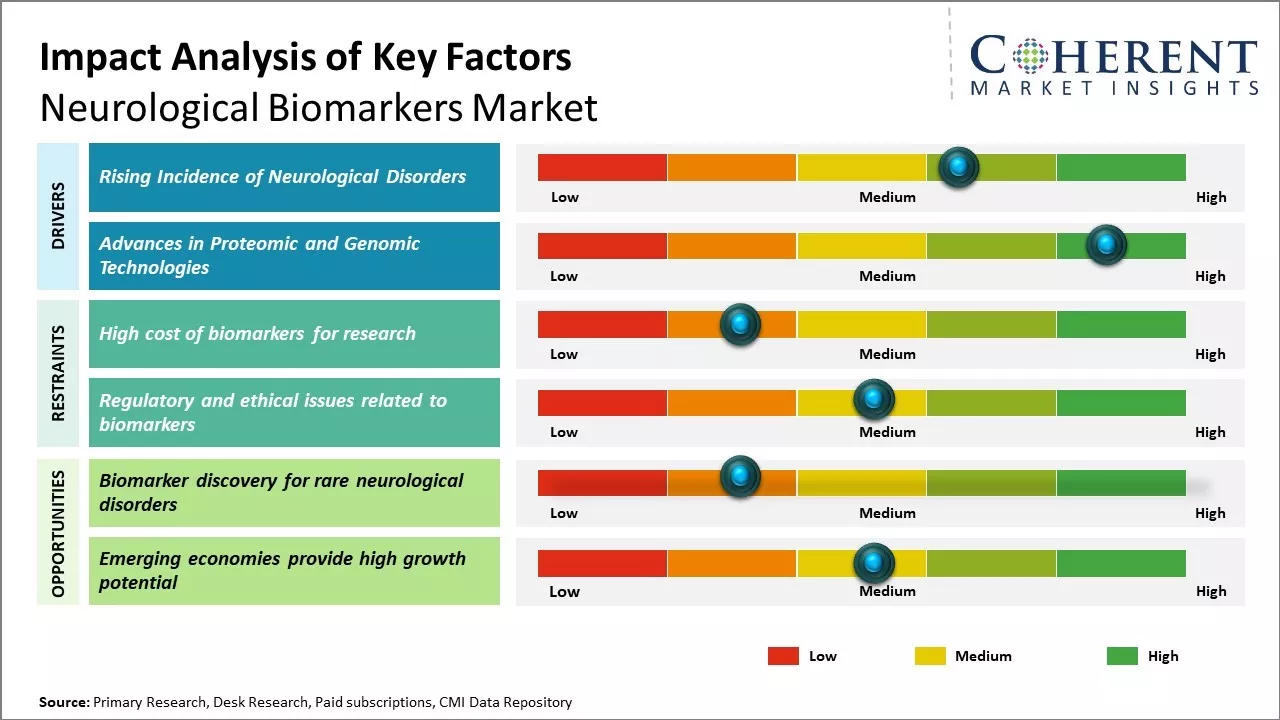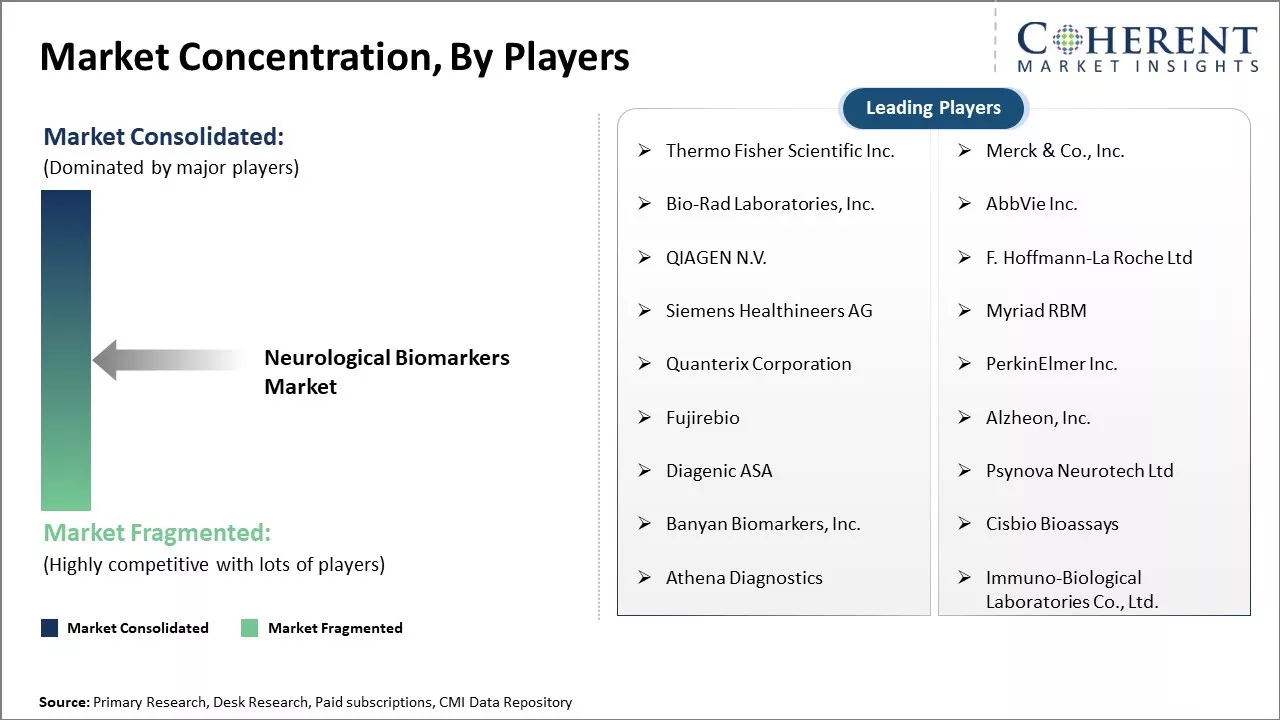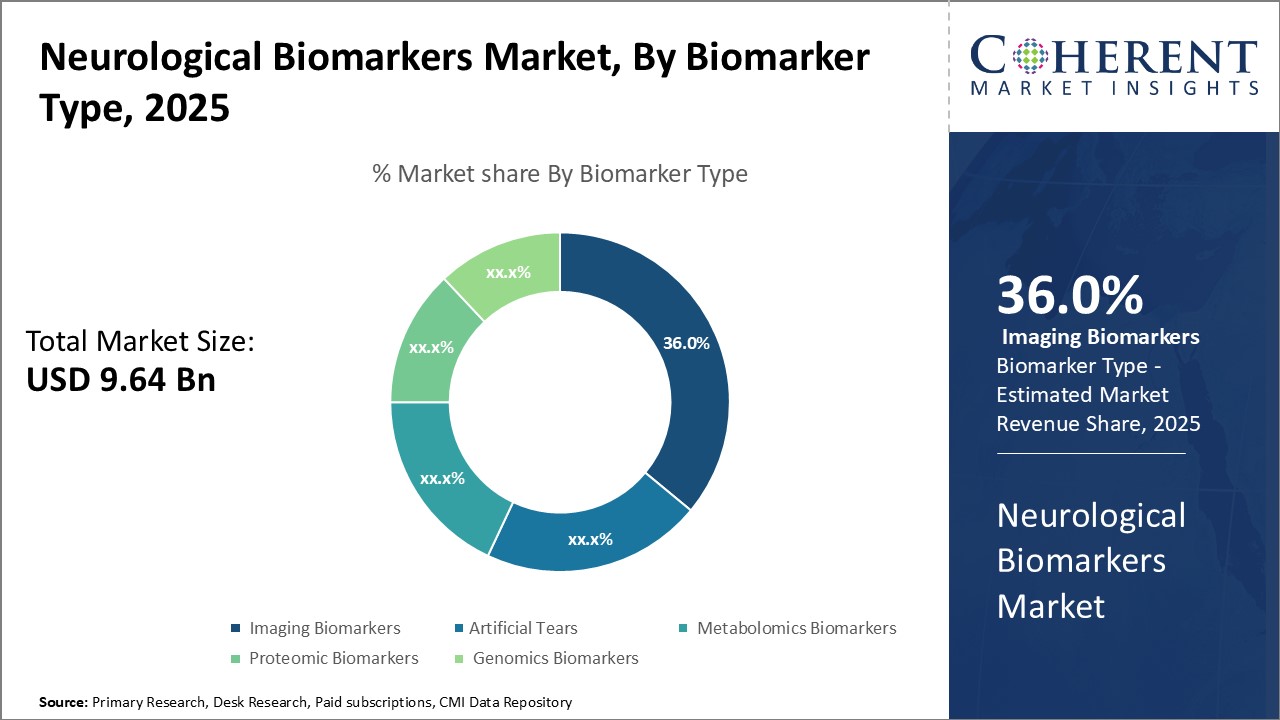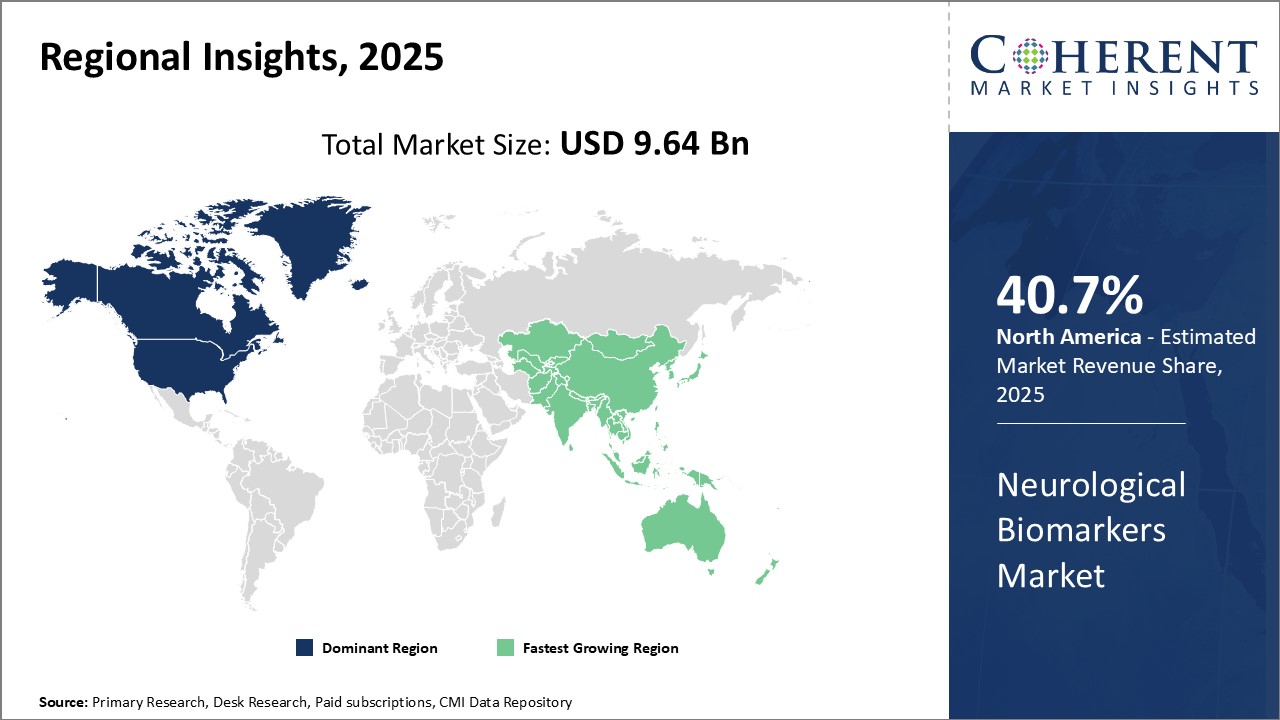Global neurological biomarkers market is estimated to be valued at USD 9.64 Bn in 2025 and is expected to reach USD 23.12 Bn by 2032, exhibiting a compound annual growth rate (CAGR) 13.3% from 2025 to 2032.

Discover market dynamics shaping the industry: Request sample copy
The market is expected to witness positive growth over the forecast period due to factors such as rising incidences of neurological disorders, increasing research & development activities related to neurological diseases, rising adoption of imaging biomarkers and growing demand for minimally invasive testing. Furthermore, ongoing research to develop novel molecular biomarkers for neuropsychiatric conditions can provide opportunities for the market players. With recent technological advancements, neurological biomarkers have emerged as potential diagnostic tools and their clinical utility is under active research globally.
Rising Incidence of Neurological Disorders
Global neurological biomarkers market growth is primarily driven by rising prevalence of neurological disorders worldwide. According to various studies, neurological disorders are becoming one of the leading causes of disability and mortality. Neurological conditions such as Alzheimer's disease, Parkinson's disease, multiple sclerosis, epilepsy, and others pose a major health burden. It is estimated that over 1 billion people suffer from some form of neurological disorder. Alzheimer's disease and epilepsy affect over 35 million and 65 million people respectively. Traumatic brain injury cases are increasing due to increasing road accidents globally. All these neurological conditions requires continuous monitoring of disease progression and treatment response through reliable biomarkers, which can aid clinical decision making. Growing incidence of neurological disorders due to growing aging population and changing lifestyle factors can boost demand for neurological biomarkers in the near future. For instance, according to the data published by WHO on March 14, 2025, a new study from the Lancet Neurology reveals that over 3 billion people globally lived with neurological conditions in 2021, making these the leading cause of illness and disability worldwide. Disability, illness, and premature death attributed to neurological conditions have increased by 18% since 1990. Most neurological deaths and health loss occur in low- and middle-income countries, where access to treatment is significantly limited compared to high-income countries.

Get actionable strategies to beat competition: Request sample copy
Advances in Proteomic and Genomic Technologies
Significant technological advancements in the field of proteomics and genomics have facilitated the discovery and validation of novel neurological biomarkers. Techniques such as quantitative proteomics, mass spectrometry imaging, next generation sequencing, bioinformatics are enabling researchers to identify potential protein, genetic and metabolic biomarkers associated with different neurological conditions. For instance, technologies have helped to identify cerebrospinal fluid and blood biomarkers for Alzheimer's disease pathology as well as potential genetic variants associated with increased Parkinson's disease risk. The advancements in imaging technologies have enabled monitoring of structural and functional changes in the brain through biomarkers. Novel technologies are also aiding the development of multi-analyte biomarker panels and disease subtyping through integrated omics analysis. This is expected to revolutionize disease diagnosis, monitoring and facilitate personalized treatment approaches. Continued investments in proteomic and genomic research globally are likely to significantly contribute towards the ongoing identification and clinical adoption of novel reliable neurological biomarkers.
Key Takeaways from Analyst:
Global neurological biomarkers market has significant growth potential. Increasing prevalence of neurological disorders such as Alzheimer's, Parkinson's, Huntington's disease, Epilepsy and other forms of dementia can boost demand for biomarkers that can help detect these conditions early and enable more effective treatment management. Technological advancements in genomics, proteomics and imaging which enable reliable identification of biomarkers from clinical samples are expected to drive the market growth. North America currently dominates the market due to presence of sophisticated healthcare systems and large research focus on neurological conditions in the region. However, Asia Pacific is predicted to be the fastest growing regional market.
The lack of definitive diagnostic tests for many neurological illnesses can hamper the market growth. There is a need for more biomarkers to be validated for reliable diagnostic use. Limited reimbursement policies for new diagnostic procedures can also restrain the market growth. Developing economies may lack expertise and infrastructure for advanced test development. However, increasing healthcare spending, collaborations between global leaders and local players could help address some of these restraints. The development of minimally invasive biofluid-based tests over expensive imaging-based techniques present an opportunity for greater accessibility and adoption in middle- and lower-income markets.
Market Challenges: High cost of biomarkers for research
The high cost associated with biomarkers research and development can hamper the growth of neurological biomarkers market. Developing novel biomarkers requires massive investments in terms of time, capital and resources. The rigorous and lengthy research activities involved in biomarker validation and qualification inflates the costs substantially. Furthermore, stringent regulatory policies related to clinical trials and approvals makes the process even more capital intensive.
For instance, according to the report published by Organization for Economic Co-operation and Development report in 2021, the average cost of developing a new medical entity and bringing it to market was USD 2.17 billion. This cost has increased nearly three-fold over the past two decades. A significant portion of these costs can be attributed to biomarker validation studies. The extensive and well-controlled clinical studies involving large patient cohorts are necessary to prove the clinical validity and utility of a biomarker but these add considerably to the expenses.
Market Opportunities: Biomarker discovery for rare neurological disorders
Biomarker discovery for rare neurological disorders can presents a major opportunity for neurological biomarkers market. Rare neurological disorders are often hard to diagnose due to the lack of clear symptoms and biomarkers. However, biomarkers can help in early and accurate diagnosis of these conditions. This has become an important area of research as many rare neurological disorders are progressive and early detection along with treatment can help stop or delay progression of the disease.
Researchers are making significant progress in identifying novel biomarkers for rare neurological disorders such as Alzheimer's disease, Parkinson's disease, amyotrophic lateral sclerosis, epilepsy, and brain tumours. According to the Orphanet Report Series published by INSERM in 2022, there are over 7,000 known rare diseases affecting over 300 million people worldwide. The report estimates that rare neurological disorders account for about 30% of all rare diseases. With growing diagnosis and prevalence rates, the neurological biomarkers market is likely to grow substantially to address the clinical research and diagnostic needs for these large number of rare diseases.

Discover high revenue pocket segments and roadmap to it: Request sample copy
By Biomarker Type: Imaging technology advancements can drive the imaging biomarkers segment growth
In terms of biomarker type, imaging biomarkers segment is estimated to contribute the highest market share of 36.0% in 2025, owing to to continuous advances in medical imaging technologies such as MRI, CT scans, PET scans and sonography. Newer imaging modalities provide high resolution images that detect even subtle changes at the molecular level. This allows imaging biomarkers to non-invasively capture quantitative or semiquantitative measures of biological processes at the anatomical, physiological and molecular level. Researchers can gain deeper insights into disease pathogenesis, drug effects, and treatment response over time through longitudinal study of imaging biomarkers. Constant improvements in hardware and software also make these technologies more affordable and accessible globally. The ability to repeatedly image the same patient over the clinical course without risks of repeated radiation exposure further boosts the utility of imaging biomarkers.
By Application: Understanding disease mechanisms can drive the Alzheimer's biomarkers segment growth
In terms of application, alzheimer’s disease segment is estimated to contribute the highest market share of 25.55 % in 2025, owing to growing research focus on elucidating the disease mechanisms and pathways. Alzheimer’s is a complex disease with heterogeneous clinical presentations and underlying pathologies. Identifying reliable biomarkers can facilitate early and accurate diagnosis, aid clinical trials, and help develop and monitor new therapies. Existing cerebrospinal fluid and neuroimaging biomarkers provide limited diagnostic ability. Newer technologies are discovering novel biomarkers in biofluids, neural tissues as well as neuronal, glial and vascular biomarkers showing promise to reflect specific disease stages and endophenotypes. A combinatorial biomarker approach tracking multiple aspects of Alzheimer's pathogenesis can serve as valuable tools for clinicians and researchers alike. The need to improve diagnosis and treatment boosts intensive biomarker research efforts in this large patient segment.
By End User: Access and expanse drive hospital laboratories segment
In terms of end user, hospital laboratories segment is estimated to contribute the highest market share of 36% in 2025 as these are often the primary point of care for patients with neurological conditions. As healthcare access expands worldwide, more patients are availing services at hospitals. Advanced hospital networks can offer consolidated neurology services and testing under one roof. This "one stop shop" convenience encourages patients to obtain biochemical, genetic and imaging tests for neurological diseases from affiliated hospital laboratories. The added advantage of interpreting biomarker tests in consultation with neurology experts also makes hospital labs a preferred destination. As healthcare systems expand capacity, hospital infrastructure grows alongside. Investments in new diagnostic technologies enable hospital labs to integrate multi-omics biomarker profiling into clinical care delivery and research. Their broad outreach ensures a steady flow of test volumes to optimize resources and maintain technical competency. Thus, access and expanse synergistically lift the competitive edge of hospital laboratories as leading neurological biomarkers end user segment.

Need a Different Region or Segment? Customize now
North America has established itself as the dominant region in the global neurological biomarkers market. The region accounts for the largest market share of 40.7% in 2025, owing to the well-established healthcare and research infrastructure. Major pharmaceutical and biotechnology companies have their headquarters in the U.S. and Canada that provides them an edge in R&D for new neurological biomarkers. Furthermore, the presence of top medical devices players engaged in neurobiology research and development boosts the regional growth market. Support from government bodies in the form of grants and funding for neuroscience projects has also propelled the market growth. Several universities and academic institutions in the U.S. and Canada are engaged in collaborative research with industry players to discover novel biomarkers.
Asia Pacific is poised to be the fastest growing region over the forecast period due to improving healthcare infrastructure and increasing expenditure on neurology care. Rapid economic development of countries such as China and India have increased access to advanced healthcare facilities. Rising focus on early disease diagnosis and availability of low-cost skilled labor for manufacturing are attracting biopharmaceutical players to establish production and R&D hubs in Asia Pacific. This has augmented investments in the regional neurological biomarkers industry.
Neurological Biomarkers Market Report Coverage
| Report Coverage | Details | ||
|---|---|---|---|
| Base Year: | 2024 | Market Size in 2025: | USD 9.64 Bn |
| Historical Data for: | 2020 To 2024 | Forecast Period: | 2025 To 2032 |
| Forecast Period 2025 to 2032 CAGR: | 13.3% | 2032 Value Projection: | USD 23.12 Bn |
| Geographies covered: |
|
||
| Segments covered: |
|
||
| Companies covered: |
Thermo Fisher Scientific Inc., Merck & Co., Inc., Bio-Rad Laboratories, Inc., AbbVie Inc., QIAGEN N.V., F. Hoffmann-La Roche Ltd, Siemens Healthineers AG, Myriad RBM, Quanterix Corporation, PerkinElmer Inc., Fujirebio, Alzheon, Inc., Diagenic ASA, Psynova Neurotech Ltd, Banyan Biomarkers, Inc., Cisbio Bioassays, Athena Diagnostics, Immuno-Biological Laboratories Co., Ltd. |
||
| Growth Drivers: |
|
||
| Restraints & Challenges: |
|
||
Uncover macros and micros vetted on 75+ parameters: Get instant access to report
Share
Share
About Author
Nikhilesh Ravindra Patel is a Senior Consultant with over 8 years of consulting experience. He excels in market estimations, market insights, and identifying trends and opportunities. His deep understanding of the market dynamics and ability to pinpoint growth areas make him an invaluable asset in guiding clients toward informed business decisions. He plays a instrumental role in providing market intelligence, business intelligence, and competitive intelligence services through the reports.
Missing comfort of reading report in your local language? Find your preferred language :
Transform your Strategy with Exclusive Trending Reports :
Frequently Asked Questions
Joining thousands of companies around the world committed to making the Excellent Business Solutions.
View All Our Clients
US Reciprocal Tax Impact Analysis On Neurological Biomarkers Market
Stay updated on tariff changes with expert insights and timely information